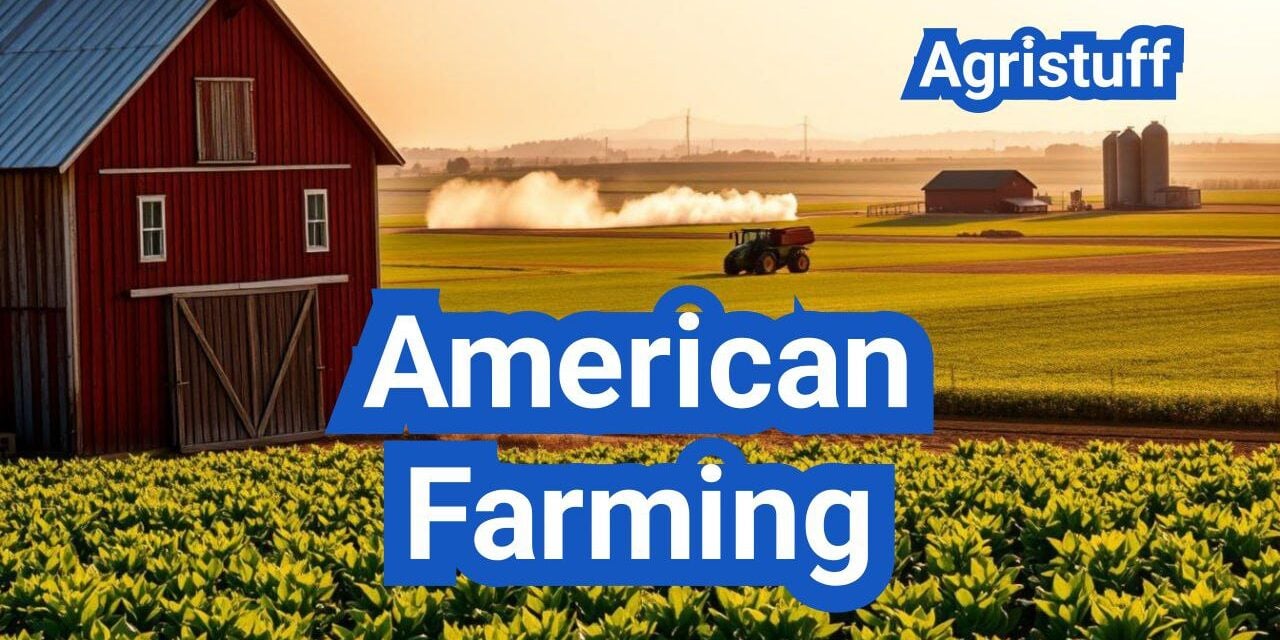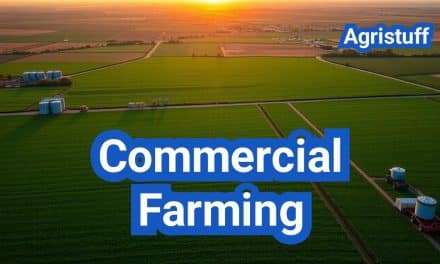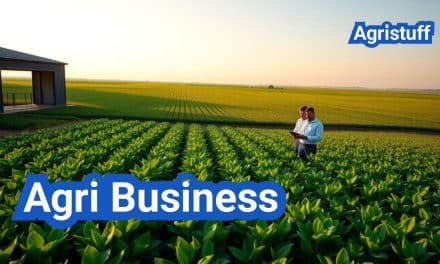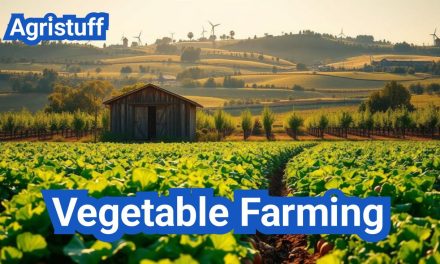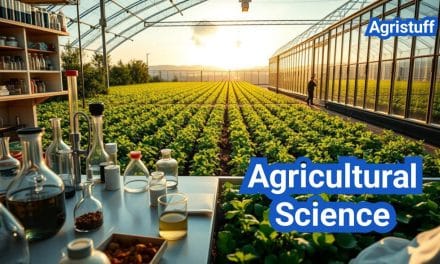The United States is home to a thriving agricultural sector, with 1.9 million farms dotting the rural landscape, and a significant portion of them being family-operated.
Agricultural practices in the country have evolved significantly over the years, from traditional methods to highly mechanized and diverse operations.
Farming in the United States has a rich history, dating back to colonial times, and has become a vital part of the country’s economy and culture.
Key Takeaways
- The United States has a large number of farms, with 95% being family-operated.
- Agricultural practices have evolved over time, incorporating new technologies and methods.
- Farming is a significant sector in the US economy and culture.
- The industry has a rich history, dating back to colonial times.
- Modern farming operations are highly mechanized and diverse.
The Heritage and Significance of American Farming
The heritage of American farming is deeply intertwined with the nation’s history, influencing its development and growth. This legacy is evident in the evolution of farming practices from colonial times to the present day.
From Colonial Agriculture to Modern Farming
American farming has undergone significant transformations since its inception. The introduction of new crops and farming techniques during the colonial era laid the foundation for the industry’s future growth.
Key Historical Milestones
The Morrill Act and the Hatch Act of 1887 were pivotal in introducing scientific agriculture to the United States, contributing to economic growth and agricultural innovation. These milestones highlight the government’s role in shaping the agricultural sector.
Technological Revolutions in Agriculture
The advent of mechanized farming equipment and later, precision agriculture, has revolutionized the industry. These technological advancements have increased efficiency and productivity, making American farming a global leader.
The Economic Impact of Agriculture in the United States
Agriculture significantly contributes to the United States’ GDP and provides employment opportunities. The industry’s economic impact is felt across various sectors, from food production to rural development.
Understanding the American Farming Landscape

The United States exhibits a wide range of farming practices across different regions. This diversity is influenced by factors such as climate, soil type, and market demand.
Regional Farming Differences Across the United States
The American farming landscape is characterized by distinct regional differences. These variations are shaped by historical, geographical, and economic factors.
Midwest Grain Belt Characteristics
The Midwest is often referred to as the “breadbasket” of America due to its extensive grain production. Corn and soybeans are the dominant crops in this region, benefiting from the fertile prairie soils and favorable climate conditions.
Southern Agricultural Practices
The Southern United States has a history of producing cotton and tobacco. However, modern farming practices in this region have diversified to include crops such as peanuts and various fruits and vegetables.
West Coast Specialty Farming
The West Coast is renowned for its specialty farming, including the production of fruits, nuts, and vegetables. The mild climate and long growing season make it an ideal location for a wide range of crops.
| Region | Primary Crops | Farming Characteristics |
|---|---|---|
| Midwest | Corn, Soybeans | Large-scale grain production, mechanized farming |
| Southern | Cotton, Tobacco, Peanuts | Diverse crop production, historical significance |
| West Coast | Fruits, Nuts, Vegetables | Specialty farming, mild climate, long growing season |
Climate Considerations for Different Regions
Climate plays a crucial role in determining the suitability of different regions for various farming practices. Understanding these climate considerations is essential for successful farming operations.
For instance, the Midwest benefits from a temperate climate with warm summers and cold winters, ideal for corn and soybean production. In contrast, the West Coast’s mild winters and long growing season allow for multiple harvests and a diverse range of crops.
How to Get Started in American Farming
For many aspiring farmers, the journey begins with understanding the fundamental requirements of agricultural entrepreneurship. Beginning farmers need to assess and acquire suitable land, secure initial capital, and pursue relevant education and training.
Essential Requirements for Beginning Farmers
Land assessment and acquisition are critical initial steps. Farmers must evaluate the quality of the land, including soil type and water availability.
Land Assessment and Acquisition
A thorough assessment involves testing soil quality, evaluating drainage, and considering the land’s history of use. This step is crucial for determining the land’s potential for different types of crops or livestock.
Initial Capital Requirements
Starting a farm requires significant initial investment, including costs for land preparation, equipment, and seeds. Understanding these costs is vital for creating a realistic budget.
According to the USDA Census of Agriculture (2022), 30% of all farmers are beginning farmers, with an average age of 47. This demographic shift underscores the need for accessible resources and training programs.
Education and Training Pathways
Agricultural Degrees and Certifications
Pursuing agricultural degrees or certifications can provide foundational knowledge in areas such as crop management, animal husbandry, and farm business management. These programs can be found at various universities and colleges across the United States.
Apprenticeship Opportunities
Apprenticeships offer hands-on experience, allowing new farmers to learn from experienced professionals. This practical training is invaluable for understanding the day-to-day operations of a farm.
Creating Your First Farm Business Plan
A comprehensive business plan is crucial for securing funding and guiding the farm’s growth. It should include market analysis, financial projections, and operational strategies.
“A good business plan is like a roadmap; it helps you navigate through challenging times and stay focused on your goals.” –
John Smith, Farmer
Key components of a farm business plan include:
- Executive summary
- Market analysis
- Financial projections
- Operational plan
| Component | Description | Importance Level |
|---|---|---|
| Executive Summary | Overview of the farm business | High |
| Market Analysis | Analysis of target market and competition | High |
| Financial Projections | Projected income and expenses | High |
| Operational Plan | Details on farm operations and management | Medium |
Types of American Farming Operations

American agriculture is a complex industry that comprises different types of farming operations, including commercial, family, and specialty farms. Understanding these various operations is crucial for appreciating the diversity and complexity of the agricultural sector in the United States.
Commercial Farming vs. Family Farming
The distinction between commercial farming and family farming lies at the heart of understanding the diverse landscape of American agriculture. While both types contribute significantly to the sector, they differ in scale, investment, and management approaches.
Scale and Investment Differences
Commercial farming operations are typically larger in scale and require substantial investment in machinery, technology, and labor. These farms are often driven by economies of scale and are focused on producing high volumes of crops or livestock for national or international markets. In contrast, family farms, which account for 95% of farms in the United States according to the USDA Census of Agriculture (2022), may operate on a smaller scale and often rely on family labor.
Management Approaches
The management of commercial farms tends to be more formal, with professional management structures and a focus on maximizing efficiency and profitability. Family farms, while also profit-oriented, often incorporate traditional practices and may prioritize sustainability and community involvement alongside financial goals.
Specialty and Niche Farming Opportunities
Beyond the traditional categories of commercial and family farming, there are numerous specialty and niche farming opportunities. These include organic farming, hydroponics, and farms specializing in unique or high-value crops. Such operations allow farmers to capitalize on specific market demands and consumer trends, often commanding premium prices for their products.
Urban and Suburban Farming Models
The rise of urban farming and suburban farming models represents a significant shift in the agricultural landscape. These operations, often located in or near urban areas, focus on producing fresh produce for local markets. They utilize innovative techniques such as vertical farming and container gardening to maximize space and efficiency. Urban and suburban farming not only contributes to food security but also helps to foster community engagement with agriculture.
Essential Equipment for Modern Farming
Modern farming has evolved significantly, relying on a wide range of essential equipment to increase efficiency and productivity. The type and scale of equipment used vary significantly depending on the size of the farming operation.
Basic Machinery and Tools for Different Farm Sizes
The equipment needed for farming varies greatly depending on whether the operation is small-scale, mid-sized, or large and commercial. Understanding these differences is crucial for farmers to make informed decisions about their equipment needs.
Small-Scale Farming Equipment
For small-scale farms, the focus is on versatile, manually operated, or small mechanized tools. These may include hand tools, small tractors, and precision farming equipment like seed drills and cultivators.
Mid-Size Operation Requirements
Mid-sized farming operations require a step up in machinery size and complexity. This can include larger tractors, plows, and harvesting equipment that can handle more land and crops efficiently.
Large Commercial Farm Machinery
Large commercial farms rely on heavy-duty machinery, including combine harvesters, large tractors, and automated farming equipment that can cover vast areas quickly and efficiently.
Technology Integration in Modern Farming
Technology has revolutionized farming, with advancements like GPS-guided equipment, drones for crop monitoring, and automated irrigation systems. These technologies improve efficiency, reduce waste, and increase crop yields.
Equipment Maintenance and Repair Schedules
Regular maintenance and timely repairs are crucial for extending the life of farming equipment and preventing costly breakdowns during critical farming periods. Creating a maintenance schedule can help farmers stay on track.
By understanding the essential equipment needs for their farm size and type, and by embracing technology and regular maintenance, farmers can significantly improve their operation’s productivity and sustainability.
Mastering Soil Management Techniques

Mastering soil management is essential for farmers looking to optimize their crop yields and reduce environmental impact. Effective soil management involves understanding the composition and health of your soil, which is crucial for making informed decisions about fertilization, irrigation, and crop rotation.
How to Test and Analyze Your Soil
Soil testing is a fundamental step in soil management. It helps determine the nutrient content, pH level, and other characteristics of your soil.
DIY Testing Methods
DIY soil testing kits are available for farmers who want to quickly assess their soil’s condition. These kits can provide immediate results and are relatively inexpensive.
Professional Testing Services
For more detailed analysis, professional soil testing services can offer comprehensive reports on soil health, including nutrient deficiencies and contamination levels.
Soil Conservation and Improvement Methods
Conserving and improving soil health is vital for sustainable farming. Techniques such as crop rotation, cover cropping, and reduced tillage can help reduce soil erosion and enhance fertility.
Seasonal Fertilization Strategies
Seasonal fertilization is critical for maintaining soil fertility throughout the year. By understanding the nutrient demands of different crops and adjusting fertilization accordingly, farmers can optimize their yields while minimizing environmental impact.
Careful stewardship by America’s food producers has spurred a 34% decline in erosion of cropland by wind and water since 1982, demonstrating the effectiveness of improved soil management practices.
Strategic Crop Selection and Rotation

The practice of crop rotation and selection is fundamental to the productivity and sustainability of farming in the United States. By choosing the right crops for specific conditions and rotating them effectively, farmers can enhance soil health, reduce pests and diseases, and improve overall yields.
Major Crops in American Agriculture
Corn, soybeans, and wheat are among the major crops grown in the United States, with the Corn Belt being a significant region for corn and soybean production. These crops are not only vital for domestic consumption but also play a crucial role in the country’s agricultural exports.
Grain and Commodity Crops
Grain and commodity crops such as corn and soybeans are staples in American agriculture. They are used for a variety of purposes, including livestock feed, biofuels, and human consumption.
Vegetable and Fruit Production
Vegetable and fruit production is another significant aspect of American agriculture, with various regions specializing in different types of produce. From California’s avocados and tomatoes to Florida’s citrus fruits, the diversity in vegetable and fruit production contributes to the country’s food security and economy.
Planning Effective Crop Rotations
Effective crop rotation is a key strategy for maintaining soil health and controlling pests and diseases. By rotating crops, farmers can break disease cycles, improve soil fertility, and reduce the need for chemical inputs.
Three-Year Rotation Examples
A common rotation might include a sequence like corn-soybeans-wheat. This rotation helps in maintaining soil health by alternating between crops with different nutrient requirements and growth patterns.
Cover Cropping Benefits
Cover cropping is another beneficial practice that involves planting crops between crop cycles to protect and enhance the soil. Cover crops can help reduce erosion, improve soil structure, and provide habitat for beneficial insects.
Specialty and High-Value Crop Considerations
Specialty crops, including fruits, vegetables, and nuts, offer high-value opportunities for farmers. These crops can provide higher returns per acre compared to traditional commodity crops, although they often require more intensive management and marketing efforts.
In conclusion, strategic crop selection and rotation are essential components of successful farming operations in the United States. By understanding the major crops, planning effective rotations, and considering specialty crops, farmers can improve their productivity and profitability while contributing to sustainable agricultural practices.
Effective Livestock Management Practices

The success of farming operations heavily relies on effective livestock management practices. Livestock management encompasses a range of activities, including selecting the right livestock for your farm type, ensuring animal health and welfare, and designing efficient livestock facilities.
Selecting Livestock for Your Farm Type
Choosing the appropriate livestock is crucial for the success of your farming operation. This decision should be based on several factors, including the farm’s resources and market demand.
Space and Resource Requirements
Different livestock have varying space and resource requirements. For instance, poultry require less space compared to cattle. It’s essential to assess your farm’s capacity to provide the necessary resources.
Market Demand Considerations
Understanding market demand is vital in selecting livestock. Farmers should consider the demand for specific livestock products in their region. For example, dairy farming is more viable in areas with high demand for dairy products.
- Assess local market trends for livestock products.
- Consider the competition and potential market share.
- Evaluate the feasibility of producing niche products.
Animal Health and Welfare Best Practices
Maintaining animal health and welfare is critical for the productivity and profitability of a farm. This involves implementing best practices such as regular veterinary check-ups, proper nutrition, and humane living conditions.
Key practices include:
- Providing adequate nutrition tailored to the livestock’s needs.
- Ensuring access to clean water at all times.
- Maintaining clean and safe living conditions.
Designing Efficient Livestock Facilities
Efficient livestock facilities are essential for reducing operational costs and improving animal welfare. The design should consider factors such as ventilation, waste management, and ease of access for both animals and staff.
By focusing on these aspects, farmers can improve the overall efficiency of their livestock management practices, leading to more sustainable and profitable farming operations.
Implementing Sustainable American Farming Methods

Sustainable agriculture is becoming a cornerstone of American agriculture, driven by consumer demand and environmental concerns. As the agricultural sector continues to evolve, farmers are adopting innovative methods to reduce their environmental footprint while maintaining profitability.
Organic Farming Certification Process
The United States has over 14,000 certified organic farms, covering more than 5 million acres (USDA). To achieve organic certification, farmers must undergo a rigorous process.
Transition Timeline and Requirements
Farmers must transition their land to organic practices for three years before being eligible for certification. This involves adopting organic farming practices such as crop rotation, composting, and avoiding synthetic fertilizers and pesticides.
Record-Keeping for Organic Compliance
Detailed record-keeping is crucial for organic compliance, including documentation of farming practices, soil testing, and input materials used.
Regenerative Agriculture Techniques
Regenerative agriculture focuses on regenerating soil health and biodiversity. Techniques include cover cropping, reduced tillage, and integrating livestock into farming systems.
Water Conservation and Management Strategies
Effective water management is critical for sustainable farming. Strategies include implementing drip irrigation systems, using drought-resistant crop varieties, and adopting conservation tillage to reduce soil erosion and improve water retention.
By adopting these sustainable farming methods, American farmers can contribute to a more environmentally friendly agricultural sector while ensuring the long-term viability of their operations.
Navigating Agricultural Regulations and Compliance

The complex landscape of agricultural regulations ( Farm Bills ) in the United States requires farmers to be well-informed and compliant. Agricultural regulations are designed to ensure the sustainability and safety of farming practices, impacting everything from environmental conservation to labor laws.
Federal Regulations Affecting American Farmers
American farmers must comply with various federal regulations, including those related to environmental protection, labor laws, and animal welfare. The U.S. Department of Agriculture (USDA) plays a crucial role in overseeing these regulations.
| Regulation | Description | Impact on Farmers |
|---|---|---|
| Environmental Protection | Regulations to protect natural resources | Requires sustainable farming practices |
| Labor Laws | Laws governing worker rights and safety | Ensures fair treatment and safe working conditions |
| Animal Welfare | Standards for the humane treatment of animals | Impacts livestock handling and housing |
State and Local Compliance Considerations
In addition to federal regulations, farmers must also comply with state and local laws, which can vary significantly. These may include zoning laws, water rights, and specific agricultural practices.
Creating Effective Record-Keeping Systems
Maintaining accurate and detailed records is essential for compliance and farm management. Effective record-keeping systems help farmers track their operations, manage resources, and demonstrate compliance with regulations.
Financial Management for Farm Profitability
To achieve success in farming, it’s crucial to implement sound financial management strategies. Effective financial management is critical for the profitability of farming operations, involving comprehensive planning, budgeting, and risk management.
Farm Business Planning and Budgeting
A well-structured farm business plan is essential for financial stability. It involves:
- Setting clear financial goals
- Identifying revenue streams
- Managing expenses
Seasonal Cash Flow Management
Managing seasonal fluctuations in cash flow is vital. Farmers must plan for periods of low revenue by:
- Creating a cash reserve
- Adjusting expenses according to seasonal income
Capital Expenditure Planning
Planning for capital expenditures ensures that funds are allocated efficiently for equipment, infrastructure, and technology upgrades.
Agricultural Loans and Financing Options
Accessing capital is crucial for farm operations. Farmers can explore various financing options, including:
- Government-backed loans
- Private lenders
- Cooperative financing
As noted by agricultural experts, “Farm programs typically cost each American just pennies per meal and account for less than one-half of 1% of the total U.S. budget.” This underscores the importance of efficient financial management in farming.
Risk Management and Insurance Strategies
Implementing risk management strategies, such as crop insurance and hedging, can mitigate potential risks. Diversifying revenue streams also helps in managing financial risks.
By adopting robust financial management practices, farmers can enhance their profitability and ensure the long-term sustainability of their operations.
Marketing and Selling Your Farm Products
In today’s agricultural landscape, marketing farm products is as important as production. With about 6% of U.S. farms marketing foods locally through direct-to-consumer sales, the potential for farmers to connect directly with consumers is significant.
Building Direct-to-Consumer Sales Channels
Direct-to-consumer sales allow farmers to retain more profit margins and build stronger relationships with their customers. This can be achieved through various channels.
Farmers Markets and CSA Programs
Farmers markets and Community Supported Agriculture (CSA) programs are popular methods for direct sales. They provide opportunities for farmers to interact with consumers and promote their products.
Farmers markets offer a platform for farmers to sell their products directly to consumers, often resulting in higher profits and customer loyalty.
On-Farm Sales Opportunities
On-farm sales, such as pick-your-own operations or farm stands, can also be lucrative. They allow consumers to experience the farm firsthand, potentially increasing customer loyalty.
“The most successful farms are those that can effectively market their products and create a loyal customer base.”
Developing Wholesale and Distributor Relationships
While direct-to-consumer sales are beneficial, wholesale and distributor relationships can help farmers reach a broader market. This involves understanding the needs of buyers and delivering products that meet their requirements.
Digital Marketing for Modern Farmers
Digital marketing is a powerful tool for farmers to promote their products. By leveraging social media, email marketing, and online platforms, farmers can reach a wider audience and increase their sales.
“The future of farming is not just about growing crops, it’s about growing businesses.”
, farmers need to embrace digital marketing to stay competitive.
Accessing Government Support Programs
Farmers across America can access a variety of government programs that offer financial aid, technical assistance, and educational resources. These programs are designed to support agricultural productivity, sustainability, and the overall well-being of farming communities.
USDA Programs and Resources
The United States Department of Agriculture (USDA) provides several programs and resources for farmers. These include:
Farm Service Agency Support
The Farm Service Agency (FSA) offers financial assistance to farmers through various programs, including loans and disaster relief.
Natural Resources Conservation Service Programs
The Natural Resources Conservation Service (NRCS) provides technical and financial assistance to farmers for conservation practices, such as soil conservation and water management.
Grants and Subsidies Application Process
To access grants and subsidies, farmers must navigate the application process, which involves submitting proposals and meeting eligibility criteria. The following table outlines key steps in the application process:
| Step | Description | Timeline |
|---|---|---|
| 1. Eligibility Check | Determine if your farm meets the eligibility criteria for the grant or subsidy. | Before Application |
| 2. Proposal Preparation | Prepare a detailed proposal outlining your project, budget, and expected outcomes. | 1-3 Months |
| 3. Application Submission | Submit your proposal through the designated application portal. | Varies |
Educational and Technical Assistance Options
Farmers can also benefit from educational and technical assistance programs offered by the USDA and other organizations. These programs provide training and resources on best practices, technology adoption, and business management.
Key Benefits: Enhanced knowledge, improved productivity, and better decision-making capabilities.
Overcoming Common Challenges in American Farming
The challenges faced by American farmers are multifaceted, ranging from weather and climate adaptation to managing pests and diseases, and addressing labor needs. These challenges can significantly impact farm productivity and profitability.
Weather and Climate Adaptation Strategies
Weather and climate-related challenges are significant concerns for farmers, with droughts and extreme weather events impacting agricultural productivity. Effective adaptation strategies are crucial for mitigating these impacts.
Drought Management Techniques
Drought management involves implementing water-saving techniques such as drip irrigation and mulching to conserve soil moisture. Crop selection and rotation can also play a crucial role in managing drought risk.
Extreme Weather Preparedness
Preparing for extreme weather events requires a comprehensive approach, including developing emergency plans, securing infrastructure, and utilizing weather forecasting tools to stay ahead of potential threats.
Integrated Pest and Disease Management
Integrated pest and disease management involves a holistic approach that combines physical, cultural, biological, and chemical controls to manage pests and diseases effectively. This approach helps minimize the environmental impact of farming while protecting crops.
Labor and Workforce Solutions
Labor shortages are a significant challenge for many American farmers. Solutions include adopting mechanization and automation technologies, improving working conditions, and accessing training programs to attract and retain skilled workers.
Embracing the Future of American Farming
As the agricultural landscape evolves, American farming is poised to benefit from cutting-edge advancements. The integration of emerging technologies is transforming the industry, making it more efficient and sustainable.
Emerging Technologies and Innovations
The adoption of precision agriculture is revolutionizing farming practices. This technology enables farmers to optimize crop yields, reduce waste, and promote sustainable farming methods.
Precision Agriculture Applications
Precision agriculture involves the use of advanced technology, such as GPS and drones, to monitor and manage crops. This approach allows for data-driven decision-making, improving overall farm productivity.
Automation and Robotics
The incorporation of automation and robotics is streamlining farming operations, from planting to harvesting. These technologies reduce labor costs and enhance efficiency, contributing to the future sustainability of American farming.
Climate Change Adaptation Strategies
As climate change continues to impact agricultural productivity, farmers are adopting innovative strategies to adapt. This includes implementing regenerative agriculture practices and developing resilient crop varieties.
New Market Opportunities and Consumer Trends
Changing consumer preferences are creating new market opportunities for American farmers. The growing demand for organic and locally sourced products is driving the development of niche farming operations.
“The future of farming is not just about producing food; it’s about creating a sustainable and equitable food system.”
Building a Sustainable and Profitable Farming Operation
Building a sustainable and profitable farming operation requires careful planning, effective management, and a commitment to continuous improvement. By understanding the heritage and significance of American farming, adopting best practices in farming operations, and navigating the challenges and opportunities that the industry presents, farmers can ensure the long-term viability of their operations.
A sustainable farming operation not only contributes to the prosperity of the agricultural sector but also plays a crucial role in maintaining the country’s natural resources. Embracing innovation and sustainability enables farmers to improve their productivity and profitability while minimizing their environmental footprint.
To achieve a profitable farming operation, farmers must stay informed about emerging technologies, market trends, and regulatory requirements. By leveraging resources from government programs, educational institutions, and industry organizations, farmers can access the knowledge and support needed to succeed in today’s competitive agricultural landscape.
In conclusion, a well-managed and sustainable farming operation is essential for the future of American agriculture. By adopting best practices, embracing innovation, and prioritizing sustainability, farmers can build a profitable and resilient agricultural business.
FAQ
What is the significance of American farming in the United States’ economy?
American farming is a vital part of the United States’ economy, contributing to the country’s GDP and providing employment opportunities.
What are the different types of farming operations in the United States?
The United States has various farming operations, including commercial farming, family farming, specialty and niche farming, and urban and suburban farming models.
How can beginning farmers get started in American farming?
Beginning farmers need to assess and acquire suitable land, secure initial capital, and pursue relevant education and training. Creating a comprehensive farm business plan is also essential.
What are the key factors to consider when selecting crops for farming?
Farmers should consider the climate, soil type, and market demand when selecting crops. Planning effective crop rotations is also crucial for maintaining soil health and reducing pests and diseases.
How can farmers implement sustainable farming practices?
Farmers can adopt organic farming practices, regenerative agriculture techniques, and water conservation strategies to implement sustainable farming methods.
What are the benefits of crop rotation in farming?
Crop rotation helps maintain soil health, reduces pests and diseases, and increases crop yields. It also allows farmers to diversify their crops and improve their overall farm productivity.
How can farmers manage livestock effectively?
Farmers should select the right livestock for their farm type, ensure animal health and welfare, and design efficient livestock facilities.
What are the emerging technologies and innovations in American farming?
Emerging technologies and innovations in American farming include precision agriculture, automation, and robotics. These technologies can help farmers improve their productivity and efficiency.
How can farmers access government support programs?
Farmers can access government support programs through the USDA, which offers various resources, grants, and subsidies. They can also seek educational and technical assistance.
What are the strategies for adapting to climate change in farming?
Farmers can adopt climate-resilient farming practices, such as using drought-tolerant crops, implementing conservation tillage, and diversifying their crops to adapt to climate change.
How can farmers manage their finances effectively?
Farmers should develop a comprehensive farm business plan, manage their cash flow, and explore agricultural loans and financing options to manage their finances effectively.
What are the marketing strategies for selling farm products?
Farmers can build direct-to-consumer sales channels, develop wholesale and distributor relationships, and leverage digital marketing strategies to sell their products effectively.
Conclusion of: American Farming
What “American farming” means today
At its core, american farming is the network of people, land, water, equipment, inputs, markets, and policies that produces the nation’s food, fiber, and fuel across every U.S. region. From small specialty growers to large-scale field crop operations, american farming adapts to climate, soils, and demand while balancing productivity with stewardship and profitability. The best single place to see the full picture of american farming—farms, acres, producers, and trends—is the official Census of Agriculture. USDA Census of Agriculture
American farming by the numbers
To understand scale in american farming, look to the most recent Census of Agriculture highlights, which summarize farm counts, land in farms, and average size, plus structural trends like consolidation and specialization. These topline statistics guide lenders, input suppliers, conservation planners, and policymakers who support american farming through cycles. Reviewing the latest national release helps you benchmark the sector and frame long-term shifts that affect farm business models and rural communities. USDA NASS: 2022 Census Highlights
Who runs American farming (mostly families)
Despite headlines about consolidation, american farming remains predominantly family-owned and operated, which shapes decision-making on succession, off-farm income, and risk tolerance. Family management influences how technology is adopted, how labor is organized, and how capital is reinvested across generations. For a clear overview of ownership patterns and farm typologies that define american farming, start with the ERS pages on structure and organization. USDA ERS: Farm Structure & Organization
Where american farming happens—regional systems
From the Corn Belt and Northern Plains to California’s Central Valley and the fruit-vegetable belts of Florida and the Pacific Northwest, american farming is actually many regional systems with different crops, yields, and marketing channels. These differences drive local land values, water demand, and labor needs. State fact sheets help you see production, income, and exports by geography—vital for understanding american farming beyond national averages. USDA ERS: State Agriculture Fact Sheets
The staple engine of american farming: corn
Corn is the backbone of american farming for feed, fuel, and food ingredients. It anchors crop rotations, shapes basis and storage decisions, and drives feed costs for livestock. Because corn accounts for the vast majority of U.S. feed-grain production and use, any shift in acres, yields, or policy ripples through prices and margins across american farming. ERS maintains a comprehensive sector overview. USDA ERS: Feed Grains at a Glance
Soybeans: the oilseed pillar of american farming
Soybeans complement corn in american farming rotations and supply crushers with meal for feed and oil for food and biofuels. Planting intentions, crush capacity, and export demand determine basis and futures spreads that producers monitor when selling. Understanding how soybeans fit into acreage decisions, input use, and processing margins is essential to risk management in american farming. USDA ERS: Soybeans & Oil Crops
Wheat, cotton, and specialty crops in american farming
Beyond corn and soy, american farming includes wheat (bread, durum, and spring classes), cotton for fiber and seed, plus specialty crops like fruits, vegetables, and tree nuts. These sectors face distinct trade dynamics, quality specs, and perishability issues, which influence storage and marketing strategies. Specialty crops, in particular, rely on temperature management, labor availability, and food-safety compliance to thrive within american farming. USDA ERS: Crop Sector Overviews
Livestock and beef: an integrated chain
The cattle-and-beef chain in american farming moves from cow-calf to stocker/backgrounder to feedlot, converting feed grains and forages into high-value protein. Feed costs, drought, and carcass weights drive margins, while exports and consumer demand shape price discovery. Understanding this integrated chain helps crop producers and pasture managers in american farming anticipate input and output price risk. USDA ERS: Cattle & Beef
Dairy: fewer herds, more milk
Dairy in american farming has trended toward larger, more efficient herds with sophisticated nutrition, genetics, and parlor tech. Milk moves into fluid products, cheese, butter, and powders, with global demand affecting prices. Cost of feed, heifer inventories, and regional processing capacity are key variables for dairy-region american farming communities. USDA ERS: Dairy
Poultry and eggs: contract models and efficiency
Poultry is a scale-efficient cornerstone of american farming, featuring contract growing, modern genetics, and integrated supply chains. Broiler, turkey, and egg segments respond quickly to feed costs and consumer demand. Growers evaluate integrator terms, housing investments, and energy needs to manage risk and returns within american farming. USDA ERS: Poultry & Eggs
Technology and precision tools reshaping american farming
Precision agriculture—GPS guidance, variable-rate input application, yield monitors, and remote imagery—has boosted decision quality across american farming. Digital tools reduce overlap, fine-tune seed and fertilizer rates, and help verify sustainability outcomes. Adoption varies by crop and region, but the trajectory is clear: american farming increasingly depends on data-driven, site-specific management. USDA ERS: Precision Agriculture in the Digital Era
Water and irrigation: lifeblood of western american farming
Irrigation underpins high-value fruits, vegetables, tree nuts, and forages in arid states, making water policy central to american farming. Trends show efficiency gains via micro-irrigation and scheduling technologies, but drought and groundwater depletion remain constraints. Understanding basin-level withdrawals and use is crucial for planning resilient american farming systems. USGS: Irrigation Water Use
Environment, climate, and emissions in american farming
Direct agricultural emissions—primarily nitrous oxide from soils and methane from ruminants—represent a notable share of U.S. greenhouse gases, placing climate mitigation on the agenda for american farming. Practices like nutrient stewardship, manure management, and cover crops help. Knowing the inventory and drivers helps farms plan practical responses within american farming. EPA: U.S. GHG Sources (Agriculture)
Conservation practices that pay: EQIP
Through EQIP, american farming operations can receive technical and financial assistance for practices that improve soil, water, air, and habitat—while maintaining productive capacity. Popular enhancements include cover crops, nutrient management, and irrigation efficiency. EQIP can de-risk adoption and speed ROI for conservation in american farming. USDA NRCS: EQIP
Stewardship at scale: CSP
The Conservation Stewardship Program (CSP) rewards whole-farm conservation performance, helping american farming advance soil health, water quality, and wildlife habitat across entire operations. By stacking enhancements and documenting outcomes, CSP supports continuous improvement and long-term resilience in american farming systems. USDA NRCS: CSP
Farm income, costs, and outlook
Profitability in american farming hinges on commodity prices, yields, input costs, interest rates, and policy payments. Monitoring ERS’s farm sector income forecasts helps producers, lenders, and suppliers align decisions with expected margins. This forward view guides capital purchases, land bids, and working-capital targets in american farming. USDA ERS: Farm Sector Income Forecast
Labor and the H-2A program
Many fruit, vegetable, and dairy operations in american farming rely on hired labor, including the H-2A temporary agricultural worker program when domestic workers are scarce. Complying with wage, housing, and transportation rules is essential to avoid penalties and ensure workforce stability across american farming. U.S. DOL: H-2A Program
Risk management: crop insurance basics
Crop insurance helps american farming manage yield and revenue risk from drought, flood, freeze, and price swings. Policies differ by crop and county; producers evaluate coverage levels, unit structures, and endorsements to fit their risk profile. A solid understanding of crop insurance basics is foundational to financial resilience in american farming. USDA RMA: Crop Insurance Basics
Organic markets and certification
Marketing products as organic within american farming requires certification under the National Organic Program (NOP). Standards govern production, handling, and labeling; accredited certifiers audit compliance. Understanding NOP rules is critical for growers and processors pursuing premium markets in american farming. USDA AMS: National Organic Program
Food safety: FSMA and farm responsibilities
The Food Safety Modernization Act (FSMA) shifted the U.S. system toward prevention, affecting produce growers and value-added processors across american farming. The Produce Safety Rule, Preventive Controls, and supply-chain programs require training and documentation that protect consumers and brands. Understanding which rules apply is vital for compliant american farming operations. FDA: FSMA Overview
Trade and exports: global demand matters
Exports absorb a significant share of bulk commodities and high-value products from american farming, supporting domestic prices and farm income. Currency moves, logistics, and foreign policies can open or constrain markets. Keeping an eye on export destinations and product mixes helps producers and merchandisers in american farming plan sales strategies. USDA ERS: U.S. Agricultural Trade
Financing options: FSA loans
For beginning and underserved producers in american farming, Farm Service Agency (FSA) loans can fill gaps for ownership, operating costs, equipment, storage, and emergencies. Direct and guaranteed options work alongside commercial lenders, helping farms stabilize and scale responsibly within american farming. USDA FSA: Farm Loan Programs
Beyond banks: the Farm Credit System
The Farm Credit System is a nationwide cooperative lender specializing in agriculture and rural infrastructure, playing a major role in financing american farming. Regulated by the Farm Credit Administration, these institutions understand seasonal cash flows, collateral needs, and risk profiles typical of american farming enterprises. Farm Credit Administration (FCA)
Taxes and records: Schedule F
Most sole-proprietor producers in american farming report business income and expenses on IRS Schedule F. Good record-keeping on inventories, depreciation, and prepaid inputs supports accurate filing, loan applications, and operational decisions. Learning the basics of Schedule F can reduce surprises and improve cash-flow planning in american farming. IRS: About Schedule F (Form 1040)
Where to get help: Cooperative Extension
County and state Cooperative Extension offices translate research into practical recommendations for american farming—from crop protection and soil health to marketing and succession planning. Workshops, fact sheets, and field days offer free or low-cost expertise that accelerates learning and adoption across american farming. USDA NIFA: Extension
Final thought
American farming is diverse, data-driven, and resilient—anchored by family ownership, powered by technology, and connected to global markets. Use the trusted resources above to benchmark your operation, plan conservation and risk management, and pursue the right finance, labor, and marketing strategies. With clear goals and reliable information, american farming can keep feeding, clothing, and fueling a growing world. USDA: Agriculture Portal
Sources & References
- USDA NASS: Census of Agriculture
- USDA NASS: 2022 Census Highlights
- USDA ERS: Farm Structure & Organization
- USDA ERS: State Agriculture Fact Sheets
- USDA ERS: Feed Grains at a Glance
- USDA ERS: Soybeans & Oil Crops
- USDA ERS: Cattle & Beef
- USDA ERS: Dairy
- USDA ERS: Poultry & Eggs
- USGS: Irrigation Water Use
- EPA: Sources of U.S. Greenhouse Gas Emissions
- USDA NRCS: EQIP
- USDA NRCS: CSP
- USDA ERS: Farm Sector Income Forecast
- U.S. Department of Labor: H-2A
- USDA AMS: National Organic Program
- USDA ERS: U.S. Agricultural Trade
- USDA FSA: Farm Loan Programs
- Farm Credit Administration
- IRS: About Schedule F (Form 1040)
- USDA NIFA: Extension

